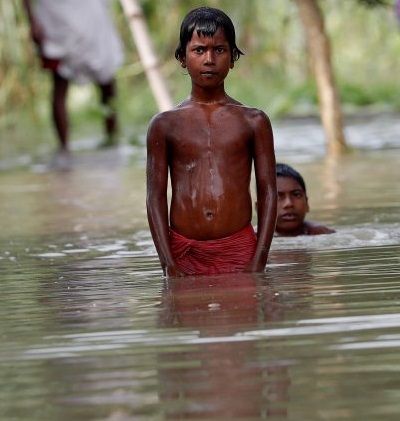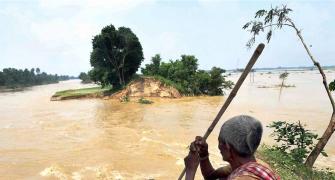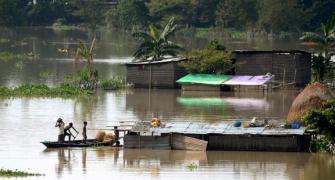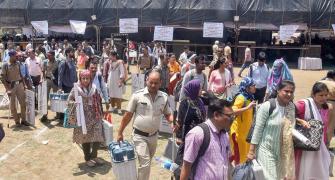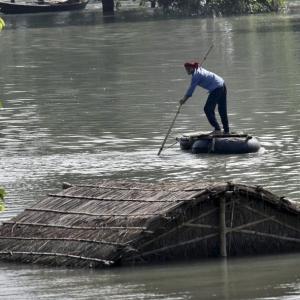'Did the government learn any lesson from the disasters of 2008, 1987, 1975?'
'Certainly not!'
'They are making people believe that the 2017 flood was unexpected, so no preventive effort towards reducing the loss of human lives was to be expected from the government,' says Mohammad Sajjad about this year's Bihar floods which have claimed over 500 lives and left 17 million people homeless.
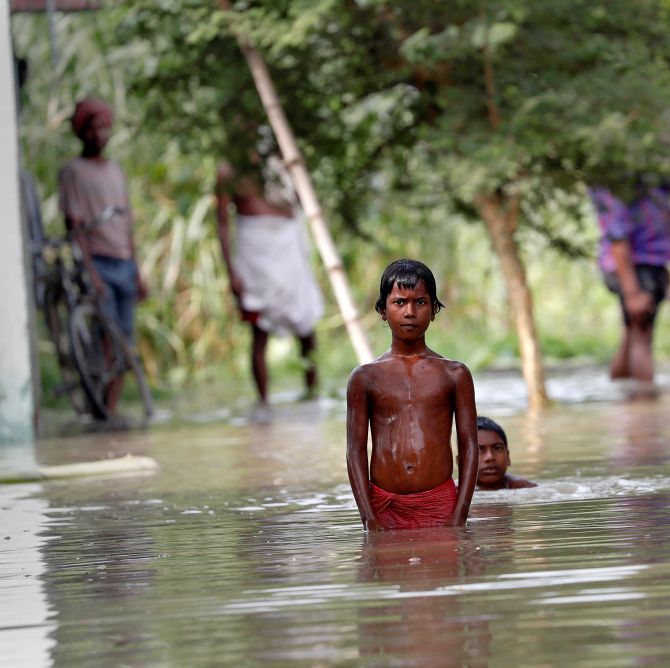
One of the greatest bottlenecks in the way of developing Bihar is recurrent floods.
But as one says this, it sounds as if Bihar is just fated to remain like that and despite all modern developments the problem is humanly impossible to solve.
That is what one needs to check first.
This time the Bihar floods are killing an unprecedentedly larger number of people.
The worst affected districts are the Kosi belt of Seemanchal; the Baghmati-Gandak belt comprising Tirhut-Mithila are affected only a little less in terms of the devastation and deaths.
Nobody is asking about the forewarning of the disaster, and about the relief measures.
Thanks to the intelligentsia (in Bihar and rhe rest of India), it has been internalised by the huge segments of the affected population that this is only a natural deluge.
Hence, no human agency -- the government -- should be blamed for anything, including relief measures.
Nobody asks that even a poor country like Bangladesh has constantly been developing and reviewing its flood management to reduce human miseries. So, why can't India do it for Bihar and other such provinces?
The fatalism is heartrending, just as it was in August 1975 when floods had unleashed only little less disaster than that of today.
So is people's apathy, and state callousness.
Reports are that policemen are throwing away dead bodies into the waters. So, the surviving kin won't even be able to claim compensation from the state.
What about the corporate houses?
In India, we hardly expect them to fulfil their social responsibilities by undertaking relief measures in such calamities.
The capital-investors, with full support of the State machinery, become too ruthless in dispossessing the peasants of their lands, but these investors won't be asked/expected to undertake relief measures.
May one recall how ruthlessly the police had killed people in Forbesganj in June 2011, to forcibly acquire their land for investors?
The very same locality (Seemanchal) is today devastated by flood and the greedy private investors are nowhere to be seen.
This reveals a distinguishing feature of capitalism in our part of the world as compared to those of the developed world.
Since the suffering masses have been indoctrinated with fatalism, they won't ask their governments, their chief minister and prime minister and the corporate houses for relief measures.
Nitish Kumar's priority is combating disunity in the Janata Dal-United.
The prime minister promptly tweeted to express his grief for the fire that had caught in the Portugal forest (June 2017). Our efficient and remarkably alert PM was so very quick in congratulating Nitish within seconds of his resignation just few weeks ago, and rejoining the NDA. But he is yet to tweet for the suffering Biharis.
The priority of the Opposition leader of Bihar, Tejaswi Yadav, was his road shows and mobilisation for the August 27 rally even while human misery and the death toll keep rising in most of north Bihar.
They stayed away in the flood of August 2008 as well when the criminal negligence of the state as well as a change in the course of the Kosi resulted in havoc on the people of Seemanchal.
Did the government learn any lesson from the particularly greater disasters of 2008, 1987, 1975? Certainly not!
There is hardly anything in the name of disaster management. They are making people believe that the flood was unexpected, so no preventive effort towards reducing the scale of losses of human lives was really to be expected from the government.
For a long time, a falsehood has been circulating that such floods are caused only when Nepal mischievously pushes out certain quantum of water.
This politics of passing the buck was exposed when then chief minister Rabri Devi had said this, creating a diplomatic problem. She had to tender an apology.
A renowned expert on Bihar floods, Dinesh Mishra, clarifies that there is no such thing about water to be held back.
Yet, at popular level a prejudice against Nepal comes up on such occasions.
As late as in 1937, Dr Syed Mahmud (1889 to 1971), the then minister of education, development and employment, in the Congress ministry had convened a huge flood conference in Patna.
The brainstorming session had underlined that multi-purpose river valley projects would help contain the flood devastation to a large extent.
This remains an unfulfilled dream.
Experts suggest that smaller dams, rather than embankment projects could have been better solution.
Cost effectiveness and structural-strategic safety of the proposed dams in a highly seismic zone is also seriously doubtful.
Ruling elites have had vested interests in embankment projects.
The huge wealth accumulated even by petty employees like the overseers (junior engineers) employed with such projects and departments of the Bihar government testify to this disgusting reality.
Since colonial days, unplanned, faulty, and hasty construction of rail-roads, and highways (with much less number of bridges) have also contributed to the disaster.
These faulty projects obstructed the natural courses of the river, making these rivers furious on such exacerbated occasions of water flow.
The combined effect of the Kosi-Kamla-Baghmati embankments have caused severe drainage congestion.
In the 1950s, some committees were instituted by the Government of India. Nothing came out of it.
Only 27 of 205 recommendations of the Rashtriya Barh Ayog (1980) were accepted. None were implemented.
The Naresh Chandra Committee Report on the 1987 flood for mitigating the sufferings in eastern Bihar is also gathering dust.
After the Kosi flood of 2008, the World Bank Rehabilitation and Resettlement Team worked in 2009-2010.
The government did not follow any of their suggestions, nor did they give the team an opportunity to to work and implement their solutions.
The Netherlands dealt with its flood problem with its strategy 'Room for Water'.
Maximum possible number of canals, annual widening of river basin, and sloping dykes on river banks have been made since 1953.
They did not control water, they made room for water, disallowed human settlements in the areas of water-logging. Human encroachment upon water spaces have been absolutely disallowed.
The only way of understanding such scale and persistence of state negligence and callousness is that Bihar is treated as India's 'Internal Colony'. Hence, it does not deserve development. It has to supply cheap labour to the developing and developed parts of India.
This is how, the scholars like Arvind N Das and Sachidanand Sinha have explained it at length. Such assertive, fearless public intellectuals are becoming extinct.
The new media (embedded as most of these are) do not help either.
All these solutions provided over the years have fallen on deaf ears of successive provincial and Union governments. Why?
Because, the death and destruction of the recurrent flooding is forgotten soon after the flood recedes. Public memory is indeed short.
State machinery undertakes relief measures more visibly only after the water recedes into the river basin.
This contributes to fattening of the corrupt bureaucracy. This is how things have sadly been going on for decades.
People reconcile with all these as a divine curse for their collective sins. Rats and foxes are blamed for breaches in embankment.
The villainy of the human agency in not undertaking flood control measures remains hidden.
The ruling elites have the last laugh!
Professor Mohammad Sajjad is with the Centre of Advanced Study in History of Aligarh Muslim University and has published two books -- Muslim Politics in Bihar: Changing Contours (Routledge, 2014), and, Contesting Colonialism and Separatism: Muslims of Muzaffarpur since 1857 (Primus, 2014).
